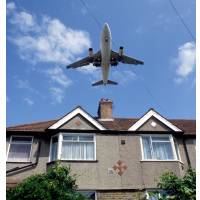Major Airlines Sued by Central Coast Residents Irate over Aircraft Noise from New Flight Path
 (photo: Environment Images/UIG/Getty)
(photo: Environment Images/UIG/Getty)
By Jon Chown, Courthouse News Service
SANTA CRUZ, Calif. (CN) - A new, more efficient airline route along California's Central Coast has drawn thousands of complaints and a lawsuit against major airlines filed by a group of Santa Cruz County residents.
Designated by the Federal Aviation Administration (FAA) as SERFR ONE, the new route channels air traffic south of San Jose, San Francisco and Oakland airports into one narrow path over parts of highly-populated Santa Cruz.
It replaces the old route, BIG SUR, which broadly directed traffic over less populated areas from the Pacific Ocean to the Santa Cruz Mountains for 40 years.
According to a Los Angeles Times report, between March and August of 2015, residents along the new route had filed 147,442 noise complaints. During the same months in 2014, there were just 5,254.
The residents' lawsuit was filed March 7 in Santa Cruz County Superior Court against the city and county of San Francisco, the city of San Jose, United Airlines, Southwest Airlines, Virgin America, American Airlines and Delta Air Lines.
It claims that the new flight path sends more than 4,000 commercial aircraft over residential properties each month and the way they are now flying those routes dramatically increases the noise and disturbance to residents below.
"Plaintiffs must endure hundreds or thousands of direct overhead flights each week, including enormously loud and otherwise disturbing flights at early morning and late night hours ... which create unbearably frequent and severe noise and vibration disturbances," the 9-page lawsuit states.
The new route is part of NextGen, described by the FAA as "a comprehensive suite of state-of-the-art technologies and procedures that, in short, enable aircraft to move more directly from Point A to Point B...while reducing fuel burn and lessening our impact on the environment."
Nationwide, the FAA says it has measured $1.6 billion in benefits to airlines from NextGen changes and in the next 15 years, an additional $11.4 billion in benefits are predicted.
The new system allows cargo planes to carry more weight and tightens the separation standards between airplanes, greatly increasing the amount of traffic that can take off and land on a runway.
The FAA estimated traffic might increase as much as 20 percent with the new standards. The FAA says the new system also reduces noise in neighborhoods, but that doesn't appear to be the case in Santa Cruz.
A number of local officials, from mayors to county supervisors, have heard complaints and passed resolutions decrying the change. U.S. Rep. Sam Farr, D-Carmel, has even entered the fray.
"This new path crosses neighborhoods that had not previously experienced significant commercial over-flights. As you may have experienced yourself, the resulting aircraft noise has dramatically impacted several neighborhoods under the new flight path," Farr said in a statement. "Previously tranquil home life has been interrupted day and night by jet noise. My office has heard from many people about noise that can shake windows, wake children, and drown out everyday conversation. I experienced this noise first hand and believe that this situation is unacceptable."
Michael Rodenbaugh of Rodenbaugh Law in San Francisco is representing himself and four others - Daniel McKay, Patricia McKay, Babak Sarashki and Kathleen Dwyer - in the March 7 lawsuit. All of them live in Santa Cruz County.
"We lived in a naturally quiet place for 11 years, seemingly a very long distance away from SFO and SJC [airports]. Then, a year ago, airlines suddenly began flying low and fast over our house, dozens to hundreds of times per day," said Rodenbaugh, who hopes to find more people to join the suit. "Thousands of our neighbors have experienced similar destruction to the peaceful enjoyment of their lives and properties."
Rodenbaugh said he is suing the airports and local governments because they are profiting from the new system at the expense of residents.
"There have been hundreds of thousands of complaints in the past year, many specifically reporting flights at illegally low altitude and illegally fast airspeed. There have been plenty of community meetings with them, yet the airports and airlines seemingly have done nothing to begin to remedy the situation," he said. "The airports have denied any liability, and the airlines probably will do the same. So, we are left with no other choice but to press ahead with litigation aimed at reasonably mitigating the ongoing nuisance as quickly as possible, finding a permanent solution that does not unfairly affect our community so severely, and forcing the companies and cities that profit from this nuisance to pay for it."
The defendants in the case, along with the FAA, have not responded to emailed requests for comment.
To Learn More:
FAA Wants No Part of Regulating Annoying Helicopters Hovering over Los Angeles (by Ken Broder, AllGov California)
- Top Stories
- Controversies
- Where is the Money Going?
- California and the Nation
- Appointments and Resignations
- Unusual News
- Latest News
- California Forbids U.S. Immigration Agents from Pretending to be Police
- California Lawmakers Urged to Strip “Self-Dealing” Tax Board of Its Duties
- Big Oil’s Grip on California
- Santa Cruz Police See Homeland Security Betrayal in Use of Gang Roundup as Cover for Immigration Raid
- Oil Companies Face Deadline to Stop Polluting California Groundwater





